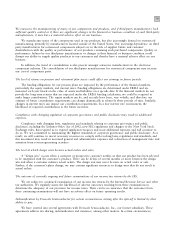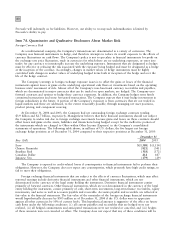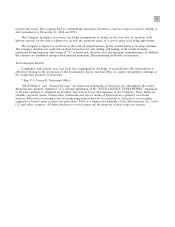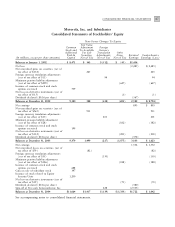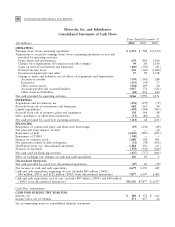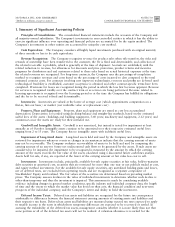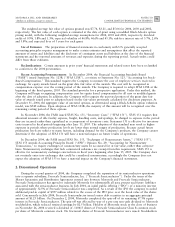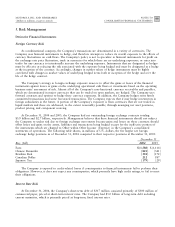Motorola 2004 Annual Report Download - page 97
Download and view the complete annual report
Please find page 97 of the 2004 Motorola annual report below. You can navigate through the pages in the report by either clicking on the pages listed below, or by using the keyword search tool below to find specific information within the annual report.
89
MOTOROLA INC. AND SUBSIDIARIES NOTES TO
CONSOLIDATED FINANCIAL STATEMENTS(Dollars in millions, except as noted)
1. Summary of SigniÑcant Accounting Policies
Principles of Consolidation: The consolidated Ñnancial statements include the accounts of the Company and
all majority-owned subsidiaries. The Company's investments in non-controlled entities in which it has the ability to
exercise signiÑcant inÖuence over operating and Ñnancial policies are accounted for by the equity method. The
Company's investments in other entities are accounted for using the cost method.
Cash Equivalents: The Company considers all highly liquid investments purchased with an original maturity
of three months or less to be cash equivalents.
Revenue Recognition: The Company recognizes revenue for product sales when title transfers, the risks and
rewards of ownership have been transferred to the customer, the fee is Ñxed and determinable, and collection of
the related receivable is probable, which is generally at the time of shipment. Accruals are established, with the
related reduction to revenue, for allowances for discounts and price protection, product returns and incentive
programs for distributors and end customers related to these sales based on actual historical exposure at the time
the related revenues are recognized. For long-term contracts, the Company uses the percentage-of-completion
method to recognize revenues and costs based on the percentage of costs incurred to date compared to the total
estimated contract costs. For contracts involving new unproven technologies, revenues and proÑts are deferred until
technological feasibility is established, customer acceptance is obtained and other contract-speciÑc terms have been
completed. Provisions for losses are recognized during the period in which the loss Ñrst becomes apparent. Revenue
for services is recognized ratably over the contract term or as services are being performed. Revenue related to
licensing agreements is recognized over the licensing period or at the time the Company has fulÑlled its obligations
and the fee to be received is Ñxed and determinable.
Inventories: Inventories are valued at the lower of average cost (which approximates computation on a
Ñrst-in, Ñrst-out basis) or market (net realizable value or replacement cost).
Property, Plant and Equipment: Property, plant and equipment are stated at cost less accumulated
depreciation. Depreciation is recorded using declining-balance and straight-line methods, based on the estimated
useful lives of the assets (buildings and building equipment, 5-40 years; machinery and equipment, 2-12 years) and
commences once the assets are ready for their intended use.
Goodwill and Intangible Assets: Goodwill is not amortized, but instead is tested for impairment at least
annually as of October. Intangible assets continue to be amortized over their respective estimated useful lives
ranging from 2 to 13 years. The Company has no intangible assets with indeÑnite useful lives.
Impairment of Long-Lived Assets: Long-lived assets held and used by the Company and intangible assets are
reviewed for impairment whenever events or changes in circumstances indicate that the carrying amount of assets
may not be recoverable. The Company evaluates recoverability of assets to be held and used by comparing the
carrying amount of an asset to future net undiscounted cash Öows to be generated by the assets. If such assets are
considered to be impaired, the impairment to be recognized is measured by the amount by which the carrying
amount of the assets exceeds the fair value of the assets calculated using a discounted future cash Öows analysis.
Assets held for sale, if any, are reported at the lower of the carrying amount or fair value less cost to sell.
Investments: Investments include, principally, available-for-sale equity securities at fair value, held-to-maturity
debt securities at amortized cost, securities that are restricted for more than one year or not publicly traded at cost,
and equity method investments. For the available-for-sale equity securities, any unrealized holding gains and losses,
net of deferred taxes, are excluded from operating results and are recognized as a separate component of
Stockholders' Equity until realized. The fair values of the securities are determined based on prevailing market
prices. The Company assesses declines in the value of individual investments to determine whether such decline is
other-than-temporary and thus the investment is impaired. This assessment is made by considering available
evidence including changes in general market conditions, speciÑc industry and individual company data, the length
of time and the extent to which the market value has been less than cost, the Ñnancial condition and near-term
prospects of the individual company, and the Company's intent and ability to hold the investment.
Deferred Income Taxes: Deferred tax assets and liabilities are recognized for the future tax consequences
attributable to diÅerences between the Ñnancial statement carrying amounts of existing assets and liabilities and
their respective tax bases. Deferred tax assets and liabilities are measured using enacted tax rates expected to apply
to taxable income in the years in which those temporary diÅerences are expected to be recovered or settled. In
assessing the realizability of the deferred tax assets, management considers whether it is more likely than not that
some portion or all of the deferred tax assets will not be realized. A valuation allowance is recorded for the


